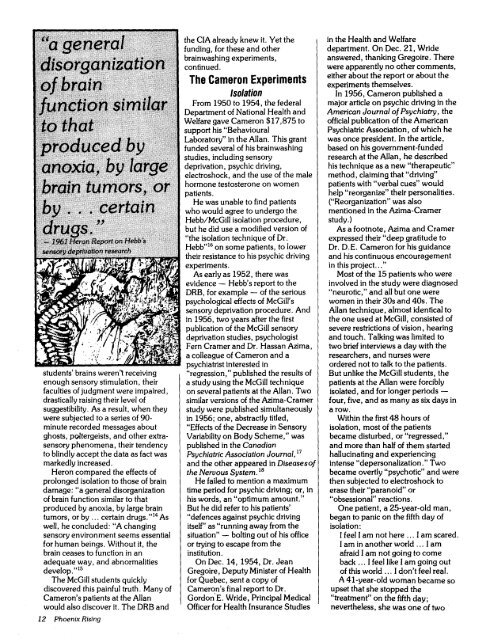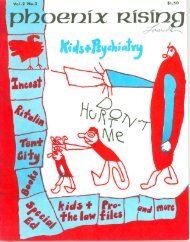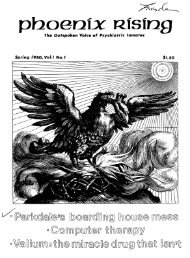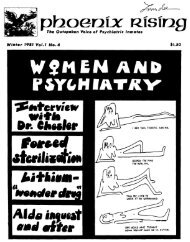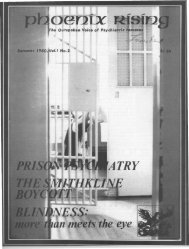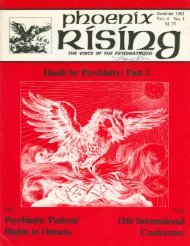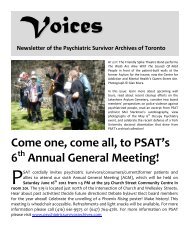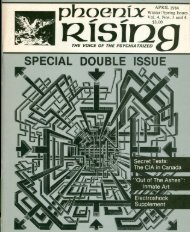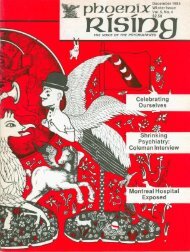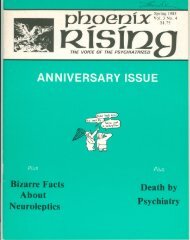Vol. 6, No. 1 - Psychiatric Survivor Archives of Toronto
Vol. 6, No. 1 - Psychiatric Survivor Archives of Toronto
Vol. 6, No. 1 - Psychiatric Survivor Archives of Toronto
- No tags were found...
You also want an ePaper? Increase the reach of your titles
YUMPU automatically turns print PDFs into web optimized ePapers that Google loves.
students' brains weren'l receivingenough sensory stimulation, theirfaculties <strong>of</strong> judgment were impaired,drastically raising their level <strong>of</strong>suggestibility. As a result, when theywere subjected to a series <strong>of</strong> 90minute recorded messages aboutghosts, poltergeists, and other extrasensoryphenomena, their tendencyto blindly accept the data as fact wasmarkedly increased.Heron compared the effects <strong>of</strong>prolonged isolation to those <strong>of</strong> braindamage: "a general disorganization<strong>of</strong> brain function similar to thatproduced by anoxia, by large braintumors, or by ... certain drugs. "14Aswell, he concluded: "A changingsensory environment seems essentialfor human beings. Without it, thebrain ceases to function in anadequate way, and abnormalitiesdevelop."15The McGillstudents quicklydiscovered this painful truth. Many <strong>of</strong>Cameron's patients at the Allanwould also discover it. The ORB and12 Phoenix Risingthe CIA already knew it. Yet thefunding, for these and otherbrainwashing experiments,continued.The CameronExperimentsIsolationFrom 1950 to 1954, the federalDepartment <strong>of</strong> National Health andWelfare gave Cameron $17,875 tosupport his "BehaviouralLaboratory" in the Allan. This grantfunded several <strong>of</strong> his brainwashingstudies, including sensorydeprivation, psychic driving,electroshock, and the use <strong>of</strong> the malehormone testosterone on womenpatients.He was unable to find patientswho would agree to undergo theHebb/McGiII isolation procedure,but he did use a modified version <strong>of</strong>"the isolation technique <strong>of</strong> Dr.Hebb,,16on some patients, to lowertheir resistance to his psychic drivingexperiments.As early as 1952, there wasevidence - Hebb's report to theORB, for example - <strong>of</strong> the seriouspsychological effects <strong>of</strong> McGill'ssensory deprivation procedure. Andin 1956, two years after the firstpublication <strong>of</strong> the McGillsensorydeprivation studies, psychologistFern Cramer and Dr. Hassan Azima,a colleague <strong>of</strong> Cameron and apsychiatrist interested in"regression," published the results <strong>of</strong>a study using the McGilltechniqueon several patients at the Allan. Twosimilar versions <strong>of</strong> the Azima-Cramerstudy were published simultaneouslyin 1956; one, abstractly titled,"Effects <strong>of</strong> the Decrease in SensoryVariabilityon Body Scheme," waspublished in the Canadian<strong>Psychiatric</strong> Association Journal,17and the other appeared in Diseases<strong>of</strong>the Nervous System. 18He failed to mention a maximumtime period for psychiCdriving; or, inhis words, an "optimum amount."But he did refer to his patients'"defences against psychic drivingitself"as "running away from thesituation" - bolting out <strong>of</strong> his <strong>of</strong>ficeor trying to escape from theinstitution.On Dec. 14, 1954, Dr. JeanGregoire, Deputy Minister <strong>of</strong> Healthfor Quebec, sent a copy <strong>of</strong>Cameron's final report to Dr.Gordon·E. Wride, Principal MedicalOfficerfor Health Insurance Studiesin the Health and Welfaredepartment. On Dec. 21, Wrideanswered, thanking Gregoire. Therewere apparently no other comments,either about the report or about theexperiments themselves.In 1956, Cameron published amajor article on psychic driving in theAmerican Journal <strong>of</strong> Psychiatry, the<strong>of</strong>ficialpublication <strong>of</strong> the American<strong>Psychiatric</strong> Association, <strong>of</strong> which hewas once president. In the article,based on his government-fundedresearch at the Allan, he describedhis technique as a new "therapeutic"method, claiming that "driving"patients with "verbal cues" wouldhelp "reorganize" their personalities.("Reorganization" was alsomentioned in the Azima-Cramerstudy.)As a footnote, Azima and Cramerexpressed their "deep gratitude toDr. D.E. Cameron for his guidanceand his continuous encouragementin this project. .."Most <strong>of</strong> the 15 patients who wereinvolved in the study were diagnosed"neurotic," and all but one werewomen in their 30sand 40s. TheAllan technique, almost identical tothe one used at McGill, consisted <strong>of</strong>severe restrictions <strong>of</strong> vision, hearingand touch. Talking was limited totwo brief interviews a day with theresearchers, and nurses wereordered not to talk to the patients.But unlike the McGillstudents, thepatients at the Allan were forciblyisolated, and for longer periods four, five, and as many as six days ina row.Within the first 48 hours <strong>of</strong>isolation, most <strong>of</strong> the patientsbecame disturbed, or "regressed,"and more than half <strong>of</strong> them startedhallucinating and experiencingintense "depersonalization." Twobecame overtly "psychotic" and werethen subjected to electroshock toerase their "paranoid" or"obsessional" reactions.One patient, a 25-year-old man,began to panic on the fifth day <strong>of</strong>isolation:I feel I am not here ... I am scared.I am in another world .. , I amafraid I am not going to comeback ... I feel like I am going out<strong>of</strong> this world ... I don't feel real.A 41-year-old wornan became soupset that she stopped the"treatment" on the fifth day;nevertheless, she was one <strong>of</strong> two


